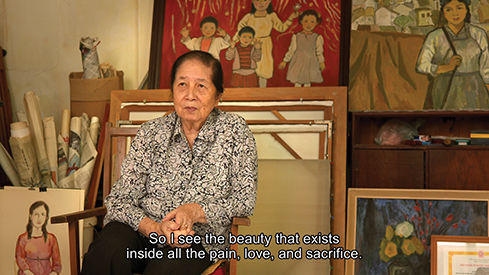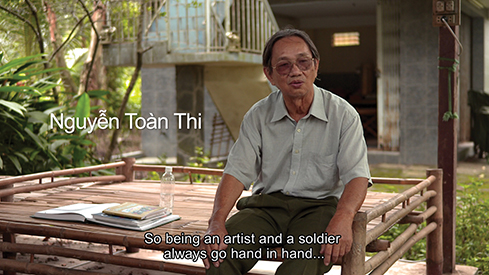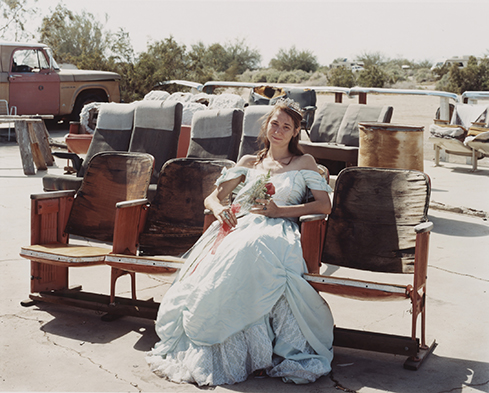 |
||||||||||
Drawings from left to right: Dương Ánh, Bải Quân Bình Đa, 1966, from Dinh Q. Lê, Light and Belief: Sketches of Life from the Vietnam War, 2012
Vũ Giáng Hương, Untitled, 1965, from Dinh Q. Lê, Light and Belief: Sketches of Life from the Vietnam War, 2012
Quách Phong, Khong Ten (Untitled), 1964, from Dinh Q. Lê, Light and Belief: Sketches of Life from the Vietnam War, 2012 |
History Redux
International artists use their stage to rethink, revive, even debunk, the past.In a little-known account of the Vietnam War, a group of Vietnamese artist-soldiers, or “warriors armed with pencils,” created a visual narrative of what life was like fighting on the front lines. Beautiful in their proficiency and melancholy, these recently rediscovered drawings and watercolors organized by Vietnamese-American artist Dinh Q. Lê offer an overlooked perspective on what the Vietnamese call the Kháng chiến chống Mỹ or the “Resistance War Against America.” The size of a small sketchpad, some works provide expected scenes from a battlefield, while others capture snapshots of life along the edges of conflict— men bathing in a river, a soldier lounging in a hammock or strumming a guitar. But it isn’t until the sketches are viewed with Lê’s accompanying film—which features candid, intimate commentary from the artwork’s proud creators—that the full weight of their impact is leveled. It’s then we learn that many of the portraits were sketched on wallet-sized paper so they could easily slip inside soldiers’ pockets, to be passed on to family should they die in combat. “The sketches are more precious than photographs,” artist-soldier Nguyễn Toàn Thi confides in the film, “because they’re drawn with our emotions.” These women and men sometimes created their work by little more than the light of the moon or the glow of exploding bombs and flares to guide them, along with a powerful emotional energy passing between artist and subject, recalls another artist, Quách Phong.“You just have to put the pencil on to the paper and you draw with that inertia,” he says. “You cannot see. It is entirely with the emotions being transmitted back and forth.”
Perhaps the most arresting thing about these portraits of war: of the 100 artworks collected by Lê for the project titled Light and Belief: Sketches of Life from the Vietnam War, none include violence. This intrigued Lê, one of Vietnam’s best-known contemporary artists, who also avoids death and destruction in his own art about the war. “For a long time, I thought they included no violence due to a directive from the Communist government; that the work was a kind of propaganda,” explains Lê, who first encountered a handful of the sketches at museums in Ho Chi Minh City. “Then I talked with some of the artists and found out that wasn’t true, that they did this on their own. I decided to start collecting the drawings, and set out to find out more about the choices the artists made, and in what conditions did they make them.” The 2013 Carnegie International will be the project’s debut in the United States, where American Vietnam War veterans are likely to be among its viewers. It’s an opportunity that Lê and the exhibition’s co-curators relish. “The current Communist government put forth a one-sided narrative of the war; that we fought against the invader and won. In reality, it’s much more complex,” says Lê, noting that the Vietnam War was also a civil war between North and South Vietnam. “The American version is all about America and left the Vietnamese completely out of it. I’ve wanted to bring the voices of the local Vietnamese overseas.” Light and Belief, like much of Lê’s work over the past 20 years, is about “filling in gaps of knowledge and understanding on both sides,” he says. This kind of fresh investigation of the past, of difference, and in Lê’s case, art’s meaning within it, pervades the 2013 Carnegie International. It’s at the heart of works by American photographers Joel Sternfeld and Taryn Simon, both known for their image-and-text-based investigations of culture; French curator and critic turned artist Pierre Leguillon; and an influential figure in Iranian documentary film, Kamran Shirdel, among others. “The sketches are more precious than photographs because they’re drawn with our emotions.”
- Artist-soldier Nguyễn Toà Thi“Approaches that enable audiences to read history from different directions are of vital interest to the show,” says Daniel Baumann, co-curator, along with Dan Byers and Tina Kukielski, “because they offer new ways to think about and interpret the world.” Of particular interest, says Byers, is challenging long-held assumptions. “This show is an opportunity to be political to a certain extent, whether looking at history from the position of those who lost, reexamining a forgotten or overlooked history, or simply looking at our own culture from a different perspective,” says Byers. “We want to challenge visitors’ sense of place in the world.” Giving VoiceBorn in South Vietnam in 1968 as the conflict was at full bore, Dinh Q. Lê spent much of his youth avoiding talk of the Vietnam War. As a young refugee living in southern California, struggling to learn English and fit in, he was quick to separate himself from his past. “I sort of put it away,” recalls Lê, now 44. Lê has little memory of the conflict. He does have memories, horrific ones, of the postwar government crackdown, and Khmer Rouge soldiers invading his hometown of Hà Tiên, near the Cambodian border, a decade later, which led to his family’s harrowing escape from Vietnam. In 1978, at age 9, he joined his mother, three of his six siblings, two aunts, five cousins, and about 70 others in fleeing the devastating Vietnam-Cambodia clash by crowded boat, first to a refugee camp in southern Thailand and then to Los Angeles. He was 11 when he reached American soil. Three of his older siblings were arrested as the family made their getaway, but two years later were able to flee again, successfully, and reunite with the family in southern California. By the time Lê reached high school, he could no longer elude his friends’ inevitable curiosity about his experiences in the land where so many Americans fought and died. “All these movies came out about the war,” explains Lê. “My friends asked me is this true, is that true. And so I kind of reluctantly entered into a dialogue.” Hollywood, Lê says, pushed him and his people to the background, depicting Vietnamese in one of three ways: as farmers in black pajamas that never spoke; a shadow in the jungle; or as prostitutes on the street. He expected more from American higher education. But while an undergraduate at the University of California at Santa Barbara, Lê signed up for Walter Capps’ legendary course about religion and the impact of the Vietnam War (highlighted three times on 60 Minutes), which proved to be a defining moment. During each class of the semester-long course, an American Vietnam veteran— sometimes two or three—would share their personal experiences of the war. Students, deeply affected, would openly weep in class, says Lê, who patiently waited for a single perspective from a Vietnamese veteran. “By the middle of the class, I was so fed up I went to the professor and asked, ‘Where are the Vietnamese? Because this is supposed to be about the Vietnam War, not just about the American involvement in the Vietnam War.’ He told me he couldn’t find any. So that was a frustration that led me to this work that has to be done.” The fact that Americans will be viewing Light and Belief at a time when their country is at war in two lands as unfamiliar to them as Vietnam was in the 1960s and 1970s is not lost on Lê. “Maybe it will force them to rethink what they know about the people in Afghanistan and Iraq, and the Vietnamese,” says Lê. “What I’m trying to do is give these people a voice.” Living the Good LifeDuring and after, but also long before the Vietnam War, a growing number of Americans sought a simpler way of life. The original thinking for these utopian communities was first established in Europe, but it was in young America that one could buy a town and suddenly start an experiment. In his 2005 work Sweet Earth, Joel Sternfeld, a pioneer in color photography in the 1970s and a senior contributor to this year’s Carnegie International, chronicles in striking images and accompanying text the utopian experiment in locations as diverse as an Arizona desert town, Chicago rooftop gardens, and the rocky coast of Maine. The project was inspired by the parallels between the country’s Transcendentalism movement—when it’s estimated some 100,000 Americans participated in 600 different utopian communities between 1810 and 1860, largely in response to the back-breaking pressures of the Industrial Revolution—and the back-to-the-land communes of the 1960s. Sternfeld’s lens also captures what he calls the third wave of communal living: today’s growing number of eco-villages and cooperative housing opportunities, the roots of which are two decades in the making. “Sweet Earth struck all of us when it came out,” recalls co-curator Kukielski. “It’s an interesting look at American history through the lens of the hopes and ideals that were sort of the founding of this country.” The communities Sternfeld highlights are a purposeful mixed bag: secular, religious, right-wing, left-wing, famous in name like the Shakers and Slab City in California, but many completely off-theradar. “It’s America in that way,” says Byers. “We wanted some projects to look at this country in the same way other artists give us a new perspective about other countries.” Regional visitors may recognize the portrait that focuses on Old Economy Village, a 19th-century community founded by the Harmonists religious collective that today is a National Historic Landmark on six acres near Ambridge, about 20 miles northwest of Pittsburgh. Sternfeld envisioned Sweet Earth as a companion to his deeply affecting study on violence in America, On This Site: Landscape in Memoriam (1996), a series of 50 photographs of infamous crime sites, unsettling in their ordinariness and forgotten history. He quickly decided pairing the two didn’t do either subject justice. Working on the two projects in tandem, however, did provide an emotional reprieve for Sternfeld, who says he underestimated the impact making images for On This Site would have on him. “My life was under a cloud for the three years that I worked on that body of work,” he says. “Every time I went someplace where something hopeful happened (for Sweet Earth), it helped remove some of that weight.” But many of America’s stories in Sternfeld’s Sweet Earth don’t have happy endings. Was he disheartened by these ideal communities that, in the end, often seemed to fall apart and fail? “Instead of being discouraged, if you look at the history I think it’s amazing that they started,” says Sternfeld. “Amazing that they thrived as long as they did. Amazing that some of the ’60s communes still exist now. Everything in the deck is stacked against them. “To go against the grain is hard,” he adds. “The fact that many of them provide an ecological model that may yet become more relevant as the climate changes or as we decide to take better care of the Earth—all of this is pretty important stuff and can make a difference.” Erasing FrictionIn a manner similar to Dinh Q. Lê, French artist Pierre Leguillon, who lives and works in Brussels, uses other people’s art to draw a new history. A curator and critic for much of his early career, in 1993 Leguillon began using photographs, snapped during his travels, to create his own art. He dubbed these non-narrative slideshows “Diaporamas,” and like a modernday vaudeville artist took them on the road, transforming them into a kind of performance art. He’ll present one of his acclaimed slideshow performances, Non-Happening after Ad Reinhardt—which includes 350 of the 10,000 slides that were used in performance lectures by the late New York abstract painter Ad Reinhardt —as part of the International on November 9, followed by a discussion with Carnegie Museum of Art Director Lynn Zelevansky. The International will be the first time Leguillon’s work will be shown in depth in the United States. For the occasion, he’ll debut two new installations that draw on the works of a pair of artists whose myths proceed them: George E. Ohr, the self-proclaimed “mad potter of Biloxi,” and French painter and entrepreneur Jean Dubuffet. Ohr, who made a name for himself by never creating two pots that were the same, was only rediscovered in the 1960s and is considered the first art potter in the United States. Dubuffet, well known internationally, dubbed the term “Art Brut,” which quickly caught on as the moniker for the proud, non-conformist style to which both artists espouse. “Pierre is especially interested in retelling those stories that are little known or forgotten tales in the history of art, and presenting them anew,” says Kukielski. “Here he’s investigating whether the myth of the artists is a product of history or the way the artists lived and portrayed themselves.”
In an installation in the Heinz Galleries, he plans to include 30 ceramic pots by Ohr, presented not in art vitrines but in a natural-history diorama case, arranged playfully around a treelike structure plastered with self-promotional images of their eccentric creator. He’ll also transform an existing wall case in the Museum of Natural History’s Hall of Botany into a panorama of printed material—books, posters, announcement cards, and pamphlets—created by Dubuffet. “In the case of Dubuffet and Reinhardt, and even Ohr, I use them as characters that have been constructed in history, but I leave aside the narrative,” says Leguillon. “I go back to the actual objects, erasing the fiction.”
Queen of the Prom, the Range Nightclub, Slab City, California, March 2005.
When Camp Dunlap, a World War II Marine training facility near Niland, California, was closed in 1946, all of the buildings were completely dismantled, leaving numerous cement foundation slabs in the desert. Almost as soon as the government abandoned the site, “snowbirds” (campers from northern states in recreational vehicles) began to winter on the slabs, even though no running water, electricity or sewage facilities were available. Today at least five thousand snowbirds arrive each winter, and a few have become permanent year-round residents, despite summer temperatures that can reach 120 degrees. The snowbirds come with motor homes costing half a million dollars and they come with tents. Over the years, a true self-governing community has arisen, including a mayor, the Slab City Christian Church (in a trailer), the Lizard Tree Library (used paperbacks on an honor system), the Gopher Flats Country Club (gravel greens), the Oasis Social Club (combination meeting space/junkyard), a CB radio station (one half hour of purely local news, nightly at six p.m.) and the Range, an outdoor nightclub built by “Builder Bill,” complete with stage, lighting, bar, communal outhouse and several rows of salvaged airliner seats. The Range takes its name from an active bombing range located a few miles away, which makes the sight and sound of F-16 sorties a part of life at the Slabs. Moira, the Queen of the 2005 Prom at the Range, never got to go to her high school prom.
|
|||||||||
2013 Carnegie International · Artist as Activist · Artists In Their Own Words · Frozen In Time · The Stand-In · Director's Note · NewsWorthy · Face Time: Lauren Talotta · Science & Nature: Cultural Craftsman · About Town: Wild by Design · The Big Picture
 |
Copyright © 2017 CARNEGIE Magazine. All rights reserved. |





